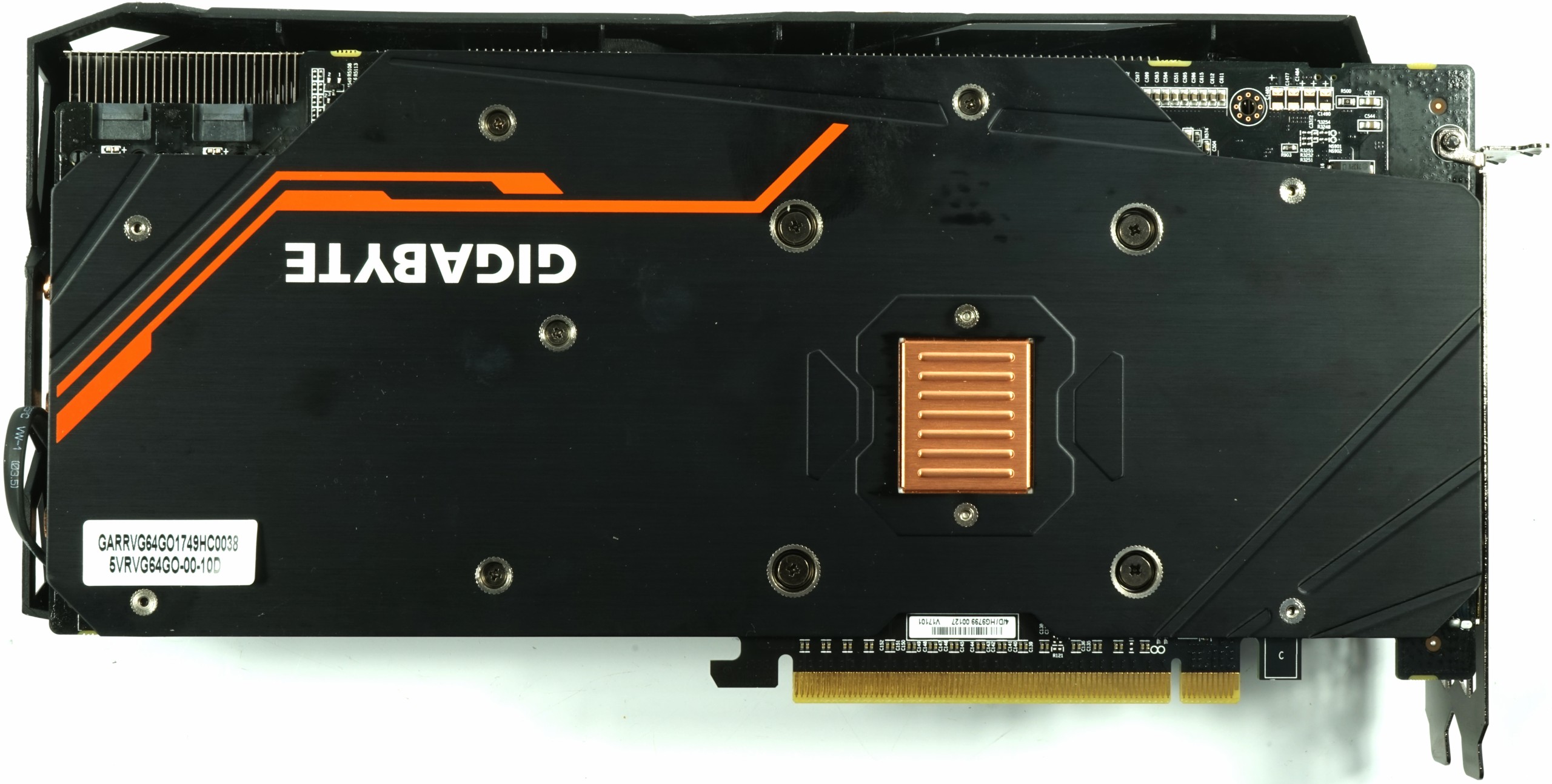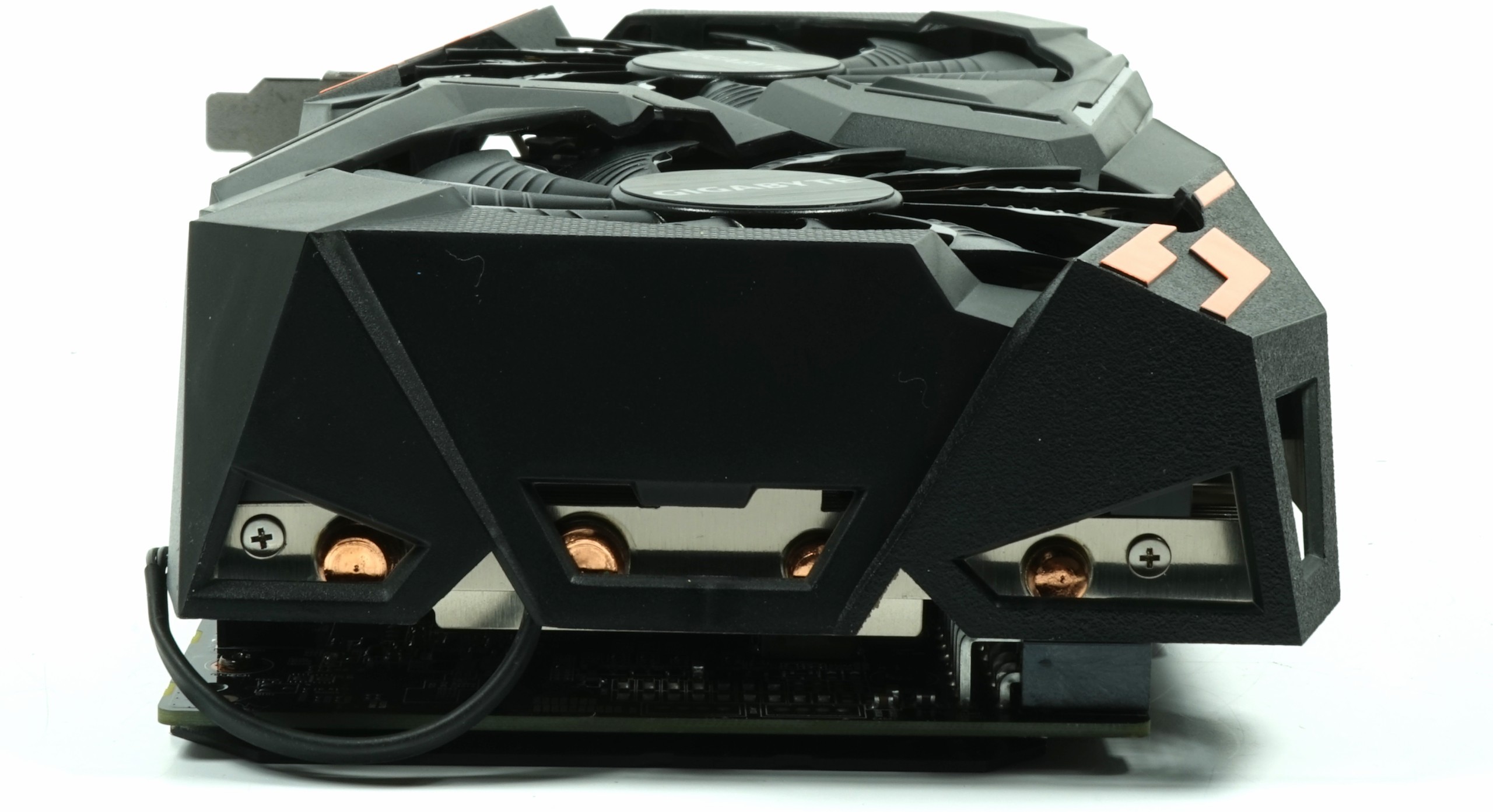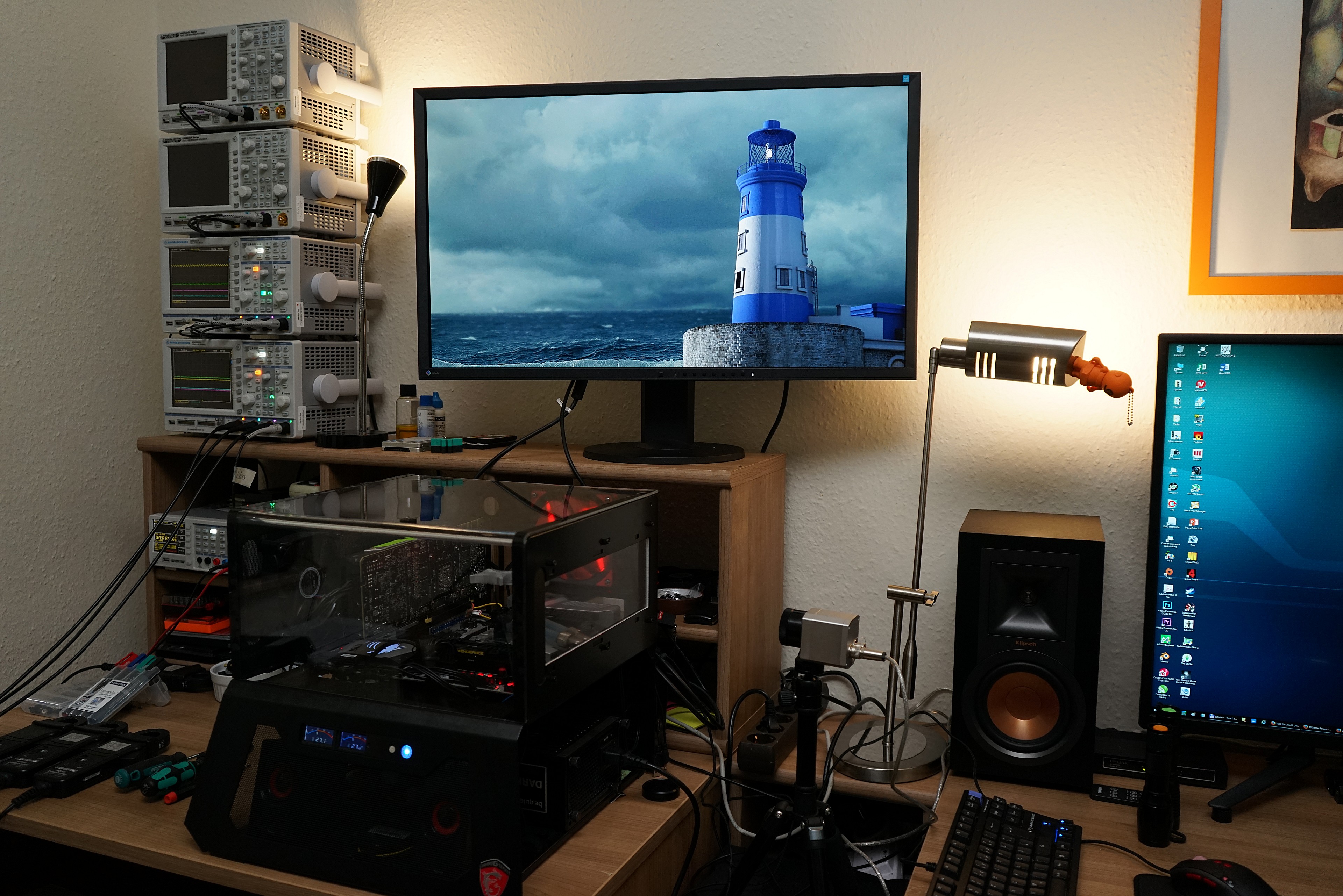Early Verdict
Gigabyte's Radeon RX Vega 64 Gaming OC 8G began life as an Aorus-branded stunner, but had to be pared back in the face of supply issues from AMD. What remains is still a very fast gaming board, albeit with a more budget-oriented cooler. Unfortunately, limited availability means there aren't many to go around.
Pros
- +
Noise-optimized design
- +
Well-implemented heat pipe direct touch cooler
- +
Great 2560x1440 gaming performance
- +
Six display outputs
- +
Improved fan speed profile via recent BIOS update
Cons
- -
Poor availability
- -
Uncertain pricing
- -
No thermal headroom for overclocking
Why you can trust Tom's Hardware
Features & Specifications
A few weeks back, we published our Sapphire Radeon RX Vega 64 Nitro+ Review, introducing the first third-party Vega-based card to land in our labs. Compared to that board, and like the Radeon RX Vega 56 Gaming OC 8G we reviewed previously, Gigabyte's Radeon RX Vega 64 Gaming OC 8G is more understated, featuring easier-to-manage weight and dimensions. It's almost like this card was designed to be ordinary-looking, so as not to generate demand that Gigabyte wouldn't be able to satisfy. Nevertheless, this is a good example of a bread-and-butter solution that covers all of the bases and still offers a different approach than AMD's reference implementation.
Specifications
Market & Availability
According to our sources, AMD's board partners have only received a few thousand Vega 10 GPUs. Thus, a general shortage of packages is preventing anyone from mass-producing notable quantities of Radeon RX Vega 56 or 64 cards. It's simply not possible to start and stop a production line over and over again. It costs too much time and money.
We were lucky to get our hands on a sample of Gigabyte's Radeon RX Vega 64 Gaming OC 8G. Buying a card of our own was the only way to get one into into the German lab. Here in the U.S., this is a mythical creature. Nobody has it for sale, and the only references online come from Gigabyte's site or product announcement news stories.
Unboxing, Look & Feel
Weighing just 1006g, Gigabyte's card is almost 600 grams lighter than Sapphire's Radeon RX Vega 64 Nitro+. This implementation is also considerably more compact, yielding a length of just 27.8cm, a height measurement of 13cm, and 4.7cm of width.
Two counter-rotating fans, each with a diameter of 9.5cm, are positioned inside 10cm openings. According to Gigabyte, its unique fan blade design splits airflow and guides it through curves on the fan surface, improving flow compared to traditional fans. Naturally, we'll test the efficacy of those claims shortly.
The backplate doesn't feature an Aorus logo, which was present on a pre-production model we briefly had our hands on. A copper insert placed on the back of the package is thermally isolated from this plate. Both components do play a role in cooling, though. Not pictured is a heat pipe that snakes around under the backplate, though we'll cover that in more depth, too.
Plan for an extra 5mm of clearance (at least) behind the Radeon RX Vega 64 Gaming OC 8G. This may cause problems on some motherboards, particularly if the heat sink/backplate intrude on an occupied expansion slot or large CPU cooler.
Get Tom's Hardware's best news and in-depth reviews, straight to your inbox.
A peek in from the bottom shows that Gigabyte optimized the shape of its vertically-oriented fins. The slight tilt and wave shape are meant to create more efficient airflow, and thus improve cooling.
Up top, it's apparent that Gigabyte paid close attention to cost. There are no RGB lighting effects or other gimmicks. Instead, you get simple injection-molded plastic and printed orange-colored highlights. The white Gigabyte logo is simply printed on. And similar to AMD's reference design, Gigabyte only requires a pair of eight-pin auxiliary power connectors.
The closed back side doesn't reveal much. We catch a mere glimpse of two 8mm and three 6mm heat pipes, along with the fans' cable. On the board itself, we see solder pads for additional components (RGB output, perhaps?) that were obviously abandoned at some point during development.
The I/O bracket is interesting because it features six connectors, rather than the reference design's five. Three HDMI 2.0 ports and three DisplayPort 1.4 outputs are available simultaneously, allowing you to connect six monitors in an Eyefinity array.
In accordance with AMD's guidelines for clock rates, Gigabyte increased the Radeon RX Vega 64 Gaming OC 8G's base and Boost frequencies significantly. Unfortunately, the maximum Boost value is unrealistic; it cannot be sustained within the board's power limit.
In comparison to the relevant reference cards the data looks as follows:
| Model | Radeon RX Vega 64 | Gigabyte RX Vega 64 Gaming OC | Radeon RX Vega 56 | GeForce GTX 1070 Ti | GeForce GTX 1080 |
|---|---|---|---|---|---|
| GPU | Vega 10 | Vega 10 | Vega 10 | GP104 | GP104 |
| Die Size | 486 mm² | 486 mm² | 486 mm² | 314 mm² | 314 mm² |
| Transistors | 12.5 billion | 12.5 billion | 12.5 billion | 7.2 billion | 7.2 billion |
| Base/Boost Clock Rate | 1247/1546 MHz | 1274/1630 MHz | 1156/1471 MHz | 1607/1683 MHz | 1607/1733 MHz |
| Shaders/SIMDs | 4096/64 | 4096/64 | 3584/56 | 2432/19 | 2560/20 |
| Texture Units/ROPS | 256/64 | 256/64 | 224/64 | 152/64 | 160/64 |
| Pixel Fill Rate | 79.8 GPix/s | 81.5 GPix/s | 74 GPix/s | 102.8 GPix/s | 114.2 GPix/s |
| Texture Fill Rate | 319.2 GT/s | 326.1 GT | 258.9 GT/s | 244 GT/s | 257.1 GT/s |
| Memory Interface | 2048-bit | 2048-bit | 2048-bit | 256-bit | 256-bit |
| Memory Type | HBM2 | HBM2 | HBM2 | GDDR5 | GDDR5X |
| Memory Bandwidth | 484 GB/s | 484 GB/s | 410 GB/s | 256 GB/s | 320 GB/s |
| Memory Speed | 1.89 Gb/s | 1.89 Gb/s | 1.6 Gb/s | 8 Gb/s | 10 Gb/s |
| Memory Size | 8GB | 8GB | 8GB | 8GB | 8GB |
| DX12 Feature Level | 12_1 | 12_1 | 12_1 | 12_1 | 12_1 |
| PCIe Power Connectors | 2x 8-Pin | 2x 8-Pin | 2x 8-Pin | 1x 8-pin | 1x 8-pin |
| TDP | 295W | 295W | 210W | 180W | 180W |
Test System & Measurement Methods
We introduced our new test system and methodology in How We Test Graphics Cards. If you'd like more detail about our general approach, check that piece out. We've upgraded the CPU and the cooling system since then to make sure that nothing's holding back graphics cards as fast as this one.
The hardware used in our lab includes:
| Test System | |
|---|---|
| Hardware | Intel Core i7-6900K @ 4.3 GHzMSI X99S XPower Gaming TitaniumCorsair Vengeance DDR4-32001x 1TB Toshiba OCZ RD400 (M.2, System SSD)2x 960GB Toshiba OCZ TR150 (Storage, Images)be quiet Dark Power Pro 11, 850W PSUWindows 10 Pro (All Updates) |
| Cooling | Alphacool Eisblock XPX5x be quiet! Silent Wings 3 PWM (Closed Case Simulation)Thermal Grizzly Kryonaut (Used when Switching Coolers) |
| Case | Lian Li PC-T70 with Extension Kit and ModsConfigurations: Open Benchtable, Closed Case |
| Monitor | Eizo EV3237-BK |
| Power Consumption Measurement | Contact-free DC Measurement at PCIe Slot (Using a Riser Card)Contact-free DC Measurement at External Auxiliary Power Supply CableDirect Voltage Measurement at Power Supply2 x Rohde & Schwarz HMO 3054, 500 MHz Digital Multi-Channel Oscilloscope with Storage Function4 x Rohde & Schwarz HZO50 Current Probe (1mA - 30A, 100 kHz, DC)4 x Rohde & Schwarz HZ355 (10:1 Probes, 500 MHz) 1 x Rohde & Schwarz HMC 8012 Digital Multimeter with Storage Function |
| Thermal Measurement | 1 x Optris PI640 80 Hz Infrared Camera + PI Connect Real-Time Infrared Monitoring and Recording |
| Noise Measurement | NTI Audio M2211 (with Calibration File, Low Cut at 50Hz) Steinberg UR12 (with Phantom Power for Microphones) Creative X7, Smaart v.7 Custom-Made Proprietary Measurement Chamber, 3.5 x 1.8 x 2.2m (L x D x H) Perpendicular to Center of Noise Source(s), Measurement Distance of 50cm Noise Level in dB(A) (Slow), Real-time Frequency Analyzer (RTA) Graphical Frequency Spectrum of Noise |
MORE: Best Graphics Cards
MORE: Desktop GPU Performance Hierarchy Table
MORE: All Graphics Content

Igor Wallossek wrote a wide variety of hardware articles for Tom's Hardware, with a strong focus on technical analysis and in-depth reviews. His contributions have spanned a broad spectrum of PC components, including GPUs, CPUs, workstations, and PC builds. His insightful articles provide readers with detailed knowledge to make informed decisions in the ever-evolving tech landscape
-
g-unit1111 I really wish we could buy these. I'd love to get a Vega 56. This GPU shortage is getting absolutely stupid.Reply -
FormatC I personally hate this stupid mining. A waste of ressources, only to feed a big bubble.Reply
And to look forward:
No VGA available means no sales of CPU, mainboards, memory etc.
The kiddies will buy consoles... Totally bad for the PC market and periphery.
-
barryv88 Again, Toms is very tight lipped about these Vega cards consistently outperforming their competitors. Hardly anything mentioned about those gaming benchmarks and the fact that the V64 eats the 1080 especially at 2560 res. AND you get a great mining card. And a $200 cheaper monitor (instead of a Gsync comparable one) thanx to Freesync. I'm counting quite alot of wins here. If only the miners didn't spoil the party!Reply -
FormatC Reply
http://www.tomshardware.com/reviews/best-nvidia-geforce-gtx-1080-graphics-cards,4725.html20634804 said:Good power analysis. I wish there were comparisons against the 1080 though.
I made such a thing long time ago. Simply pick a card of your choice and compare it. The 1080 is in a few months old iron ;)
No hash rate benchmarks? Disappointed:(
It is a gaming card, not just another card to feed the mining bubble. The current market situation is the result of all this mining shit. Greed eats brain - not with me. Please don't ask me, how I got these both samples. You see any other reviews of this GB cards? :)
Hardly anything mentioned about those gaming benchmarks
Of course, I could have added a performance/watt curve as well. It has all some pros and cons. Sometimes it's just better to keep quiet. Everyone can read, what he prefer. :)
-
pepar0 Personally, I think the tech/gaming media should STOP reviewing graphics cards that cannot be purchased. Nor couldn't be afforded if they could be found. This is not out of wanting to punish the GPU makers, but is rather a practical and principals matter. Plus it might cause GPU makes to rethink their positions; gamers will be here if digital currencies evolve to where mining is not needed.Reply -
g-unit1111 Reply20634712 said:Again, Toms is very tight lipped about these Vega cards consistently outperforming their competitors. Hardly anything mentioned about those gaming benchmarks and the fact that the V64 eats the 1080 especially at 2560 res. AND you get a great mining card. And a $200 cheaper monitor (instead of a Gsync comparable one) thanx to Freesync. I'm counting quite alot of wins here. If only the miners didn't spoil the party!
I'd *LOVE* to buy a Vega 56 or Vega 64 especially to compare with my 1080, and the Vega platform is pretty solid. The GPU makers really need to start taking steps to end this madness. The GPU shortage is getting to be ridiculously stupid on every level.








